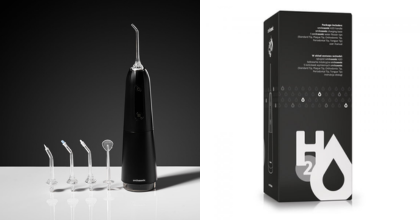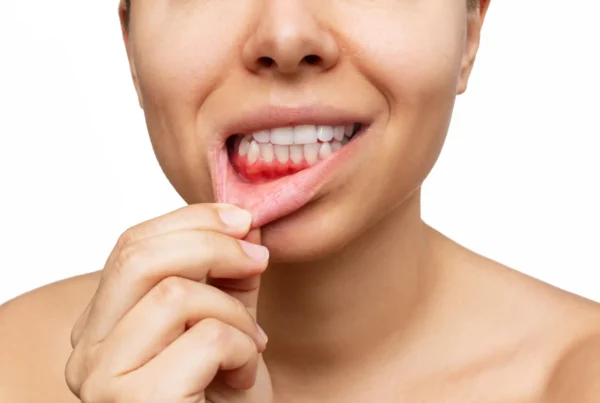A dental water flosser is a highly useful device that supports oral hygiene, especially in hard-to-reach areas such as interdental spaces. To ensure that the device remains efficient and hygienic, regular cleaning and descaling are essential. Improper maintenance can lead to limescale buildup, bacterial growth, and reduced lifespan of the irrigator. In this article, you will learn how to care for your water flosser step by step to keep it working effectively for years.
What is a water flosser and how does it work?
A dental water flosser is a tool designed for daily oral care. It uses a pressurized stream of water to clean difficult areas like interdental gaps, gum lines, and around braces. Both countertop and cordless models are excellent at removing plaque and food particles from tight spots in the mouth. This device works by flushing out food debris, bacteria, and dental plaque, making it a perfect addition to everyday tooth brushing. It is especially recommended for people with sensitive gums, braces, implants, or dental bridges. While a water flosser does not replace a toothbrush, it complements overall oral hygiene by enhancing gum and tooth cleanliness.
Why is regular cleaning of a water flosser important?
Routine cleaning is essential to ensure your flosser remains both hygienic and effective. Tap water, commonly used in these devices, can cause limescale deposits and encourage bacterial growth in the tank, tubing, and nozzles. Neglecting to clean the device promotes mold, fungi, and other microorganisms, which can negatively affect oral health and lower the device’s performance. Furthermore, limescale buildup can clog the internal system, reducing efficiency and potentially leading to damage. Descaling and disinfecting your flosser on a regular basis helps maintain its longevity and optimal function.
How to clean a dental water flosser?
Frequent descaling is necessary to preserve the device’s performance. A working water flosser uses water that, when left in the tank, hoses, or nozzles, becomes a breeding ground for bacteria, mold, and fungi. Additionally, minerals like calcium and magnesium from tap water may accumulate, forming limescale. Daily maintenance prevents buildup and helps prolong the life of the flosser. This is especially important for people using it for therapeutic purposes, such as gum disease treatment.
- Rinse the tank after every use. Empty the water tank and rinse it thoroughly after every use. Leaving water inside can encourage residue and bacteria growth. Allow the tank to air-dry completely before the next use by keeping it open.
- Remove water from the tubing. Water left inside the tubing can result in limescale or mold. To avoid this, run the flosser for a few seconds with an empty tank to flush out any remaining water.
- Clean the tips regularly. The nozzles should be rinsed under running water after every use to remove residue. If detachable, allow them to dry in a clean place. Occasionally soak the tips in an antibacterial solution for deeper disinfection.
- Avoid moisture buildup. Moisture encourages bacterial growth. Ensure all parts of the device, especially the tank and tips, are dry after each use. Store the device in a well-ventilated area to allow moisture to evaporate.
- Check the device condition. Inspect the tubing, seals, and nozzles regularly. Look for signs of wear or damage to keep your device functioning safely.
How to descale a water flosser effectively?
Using tap water often leads to mineral buildup, so descaling is necessary to maintain the device’s function. A popular method involves using a 1:1 mixture of vinegar and water. Vinegar effectively dissolves limescale and cleans internal parts. Fill the tank with the solution and run the device briefly. Let the solution sit inside for about 10 to 15 minutes. Then rinse the device thoroughly with clean water to remove any vinegar odor.
Alternatively, citric acid can be used by dissolving 2 to 3 teaspoons in a glass of water. Commercial descaling agents are also effective. A recommended product is Redesept powder, which disinfects and cleans thoroughly. After any descaling process, rinse the device with clean water. Antibacterial agents not only clean but also prevent harmful bacteria from multiplying.
READ MORE:
How to care for water flosser tips?
Tips should be rinsed under running water after each use. Filtered water is better than tap water. Once every one or two weeks, soak the tips in a vinegar and water solution or citric acid solution to remove limescale and bacteria. Replace tips every few months as recommended by the manufacturer. Store them in a dry, clean place to prevent contamination.
How to use a water flosser properly?
Turn on the device and place the nozzle at a 90-degree angle to the gum line. Start from the back teeth and move along the gum line slowly to flush away food debris and plaque. Keep your mouth slightly open to let water flow out. After use, rinse the device with a cleaning agent to prevent internal buildup. Turn off the device and empty the water tank.
Additional cleaning and disinfection tips
If possible, use distilled or filtered water to reduce limescale risk. Never leave liquids inside the tank, especially mouthwash, which can leave damaging residues. Dry all components thoroughly and keep the tank open to allow proper air drying. Store the device in a dry place to avoid mold growth.
Summary
Thorough cleaning and descaling are key to the long-lasting and effective performance of your dental water flosser. Always follow the manufacturer’s instructions. Regular rinsing, descaling with vinegar or citric acid, and cleaning the tips help prevent bacteria and mineral buildup. Use specialized products like Redesept for deeper disinfection. Though easy to use, a water flosser needs proper care to remain hygienic and functional. With consistent maintenance, your device will support your oral health for many years.






